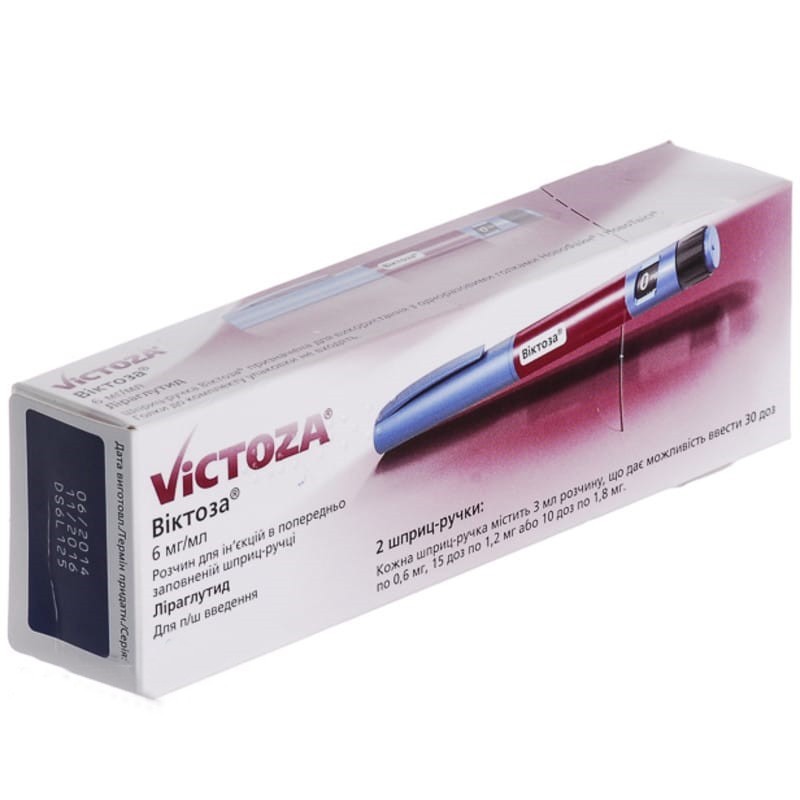



 Secure and encrypted payment processing
Secure and encrypted payment processing We ship to over 40 countries including the USA, UK, Europe, Australia and Japan
We ship to over 40 countries including the USA, UK, Europe, Australia and Japan Guaranteed refund or reship if you haven't received your order
Guaranteed refund or reship if you haven't received your ordermechanism of action. liraglutide is an analogue of glucagon-like peptide-1 (hpp-1) with an amino acid sequence 97% homologous to human hpp-1, which binds to and activates hpp-1 receptors. hpp-1 receptor is a target for native hpp-1 (the incretin-secreting hormone secreted endogenously), which potentiates glucose-dependent insulin secretion by pancreatic β-cells. unlike native GPP-1, the pharmacokinetics and pharmacodynamics of liraglutide in humans make it possible to administer it once a day. the prolonged action of the administered s / c liraglutide is due to three mechanisms: self-association, which slows down absorption, binding to blood albumin, and increased resistance to the action of dipeptidyl peptidase iv (dpp-iv) and neutral endopeptidase (NEP) enzymes, which is manifested in a prolonged t½ drug from blood plasma .
The action of liraglutide is mediated by a specific interaction with GLP-1 receptors, which leads to an increase in cAMP level. Liraglutide stimulates insulin secretion depending on glucose level and at the same time reduces inadequately high glucagon secretion also depending on blood glucose level. So, with a high concentration of glucose in the blood, insulin secretion increases, and glucagon decreases. Conversely, with hypoglycemia, liraglutide reduces insulin secretion, but does not affect glucagon secretion. The mechanism for lowering blood glucose also includes a slight slowdown in gastric emptying. Liraglutide reduces body weight and fat mass by reducing hunger and energy consumption.
Effects due to the pharmacodynamics of the drug. Liraglutide acts for 24 hours and improves glycemic control by lowering fasting blood glucose and after eating in patients with type II diabetes.
Glucose-dependent insulin secretion. Liraglutide increases insulin secretion with an increase in blood glucose concentration. In patients with type II diabetes mellitus after a single injection of liraglutide, the intensity of increasing the concentration of insulin in the blood during a staged glucose infusion was the same as in healthy volunteers.
Clinical efficacy. To assess the effects of the drug Victoza on glycemic control, 5 double-blind, randomized, controlled clinical trials were conducted. The treatment with Victoza contributed to the clinically and statistically significant compared with placebo normalization of the level of glycosylated hemoglobin A1c (HbA1c), fasting plasma glucose concentration and after eating.
These studies were conducted with the participation of 3978 patients with type II diabetes mellitus (2501 patients received Victoza), 53.7% of men, 46.3% of women, 797 patients (508 received Victoza) were ≥65 years old, and 113 patients ( 66 received the drug Victoza) - ≥75 years.
In addition, an additional randomized randomized controlled trial was conducted in which the efficacy of the drug Viktoza and Exenatide was compared.
In a 52-week clinical trial, the additional administration of insulin to Detemir in patients who did not achieve the target glycemic control level with treatment with 1.8 mg Viktoza and metformin helped lower HbA1c levels by 0.54% from the level before treatment. In patients receiving the drug Victoza 1.8 mg and metformin, the decrease was 0.20%. In this case, a decrease in body weight continued.
Glycemic control. Treatment for 26 weeks with Victoza in combination with metformin, glimepiride or metformin + rosiglitazone made it possible to achieve a statistically significant (p0.0001) and stable decrease in HbA1c concentration compared to placebo (Tables 1 and 2).
Table 1The results of two 26-week studies. Victose in combination with metformin and Victose in combination with glimepiride
| Combination Therapy with Metformin | 1.8 mg liraglutide + metformin3 | 1.2 mg liraglutide + metformin3 | Placebo + Metformin3 | Glimepiride2 + metformin3 |
|---|---|---|---|---|
| N | 242 | 240 | 121 | 242 |
| Average HbA1c,% | ||||
| Baseline | 8,4 | 8,3 | 8,4 | 8,4 |
| Starting Level Change | –1,00 | –0,97 | 0,09 | –0,98 |
| Patients who have achieved HbA1c 7%,% | ||||
| All sick | 42,4 | 35,3 | 10,8 | 36,3 |
| Previous monotherapy with oral hypoglycemic agents | 66,3 | 52,8 | 22,5 | 56,0 |
| The average body weight, kg | ||||
| Baseline | 88,0 | 88,5 | 91,0 | 89,0 |
| Starting Level Change | –2,79 | –2,58 | –1,51 | 0,95 |
| Combination therapy with glimepiride | 1.8 mg liraglutide + glimepiride2 | 1.2 mg liraglutide + glimepiride2 | Placebo + Glimepiride2 | Rosiglitazone1 + glimepiride2 |
| N | 234 | 228 | 114 | 231 |
| Average HbA1c,% | ||||
| Baseline | 8,5 | 8,5 | 8,4 | 8,4 |
| Starting Level Change | –1,13 | –1,08 | 0,23 | –0,44 |
| Patients who have achieved HbA1c 7%,% | ||||
| All sick | 41,6 | 34,5 | 7,5 | 21,9 |
| Previous monotherapy with oral hypoglycemic agents | 55,9 | 57,4 | 11,8 | 36,1 |
| The average body weight, kg | ||||
| Baseline | 83,0 | 80,0 | 81,9 | 80,6 |
| Starting Level Change | –0,23 | 0,32 | –0,10 | 2,11 |
1Rosiglitazone 4 mg / day; 2glimepiride 4 mg / day; 3metformin 2000 mg / day.
table 2The results of two 26-week studies. Victose in combination with metformin + rosiglitazone and Victose in combination with glimepiri